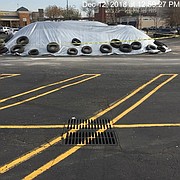Salt season is upon us. On Nov. 6, Virginia Department of Transportation (VDOT) announced they were ready to spread 2.1 million gallons of salt brine and 690,000 tons of granular salt, sand and abrasives on the state’s 128,000 miles of roads to make them safe for drivers in any winter weather. Homeowners, shopping centers and others typically use similar amounts to reduce the adherence of snow and ice to pavement. Deicing can reduce crash frequency by 88.3 percent and cut the average cost of each crash by 10 percent, according to a Minnesota study
A U.S. Geological Survey study found that many of the nation’s streams and rivers, including the Potomac River, are becoming saltier. In the Mid-Atlantic, a major contributor is road salt.
Share Your Views
The Virginia Department of Environmental Quality (DEQ) has developed a salt management strategy (SaMS) or toolkit for Northern Virginia, intended to offer best practices and educational information. On Jan. 21, at 6:30 p.m., DEQ will hold a virtual public meeting on the toolkit followed by a 30-day comment period.
The toolkit in part grew out of a regulatory requirement called total maximum daily loads (TMDLs) for Accotink Creek, which drains 52 square miles of Northern Virginia and has “chloride impairments” that harm aquatic life. A TMDL represents the total pollutant loading that a waterbody can receive without exceeding water quality standards. DEQ assumes that other streams across Northern Virginia are in a similar condition.
On the salt strategy, Thomas Faha, Director of DEQ's Northern Regional Office, comments, "We have high hopes that it will advance efforts to meet winter public safety goals while reducing negative impacts of salts on the environment and drinking water supplies in the years ahead."
Public Meeting on Salt Management Strategy (SaMS) Toolkit
Thu, Jan 21, 2021; 6:30 PM - 8:30 PM EST
https://www.deq.virginia.gov/water/water-quality/tmdl-development/salt-management-strategy-development; David.Evans@DEQ.Virginia.gov; 703-583-3835. To register for the meeting, visit https://register.gotowebinar.com/register/2180983979203362831.
Salt’s Harms
Salts do not bio-degrade, so they accumulate and end up in streams, rivers and the ocean. Drinking water agencies, like Fairfax Water, lack the technology to remove salt, and it is prohibitively expensive, they argue. Increased salinization in the region “could impact the local ecology and, from a drinking water perspective, the need for a costly change to our drinking water treatment processes,” says Fairfax Water’s Susan Miller, Public Affairs Manager.
Elevated salt in drinking water can pose human health risks, especially for people on low-sodium diets. Because salt is corrosive, it can deteriorate highway infrastructure like bridges. Salt also accelerates corrosion of metal in vehicles.
Wildlife attracted to road salt can create hazards. About 200 people are killed annually in approximately one million crashes because of animals on roads.
Birds often mistake road salt crystals for seeds or grit. When ingested, salt can be lethal to birds, reports the New Hampshire Department of Environmental Services. Excessive salt can degrade soil, water and terrestrial and aquatic plants and animals. Salty sprays from vehicles, spreaders and the wind and runoff can disrupt nutrient uptake and kill trees near roads.
VDOT applies salt to prevent ice bonding to roads, not to melt snow or ice, explains Branco Vlacich, VDOT’s Maintenance Division Administrator. If they expect roads to freeze, spreaders apply brine 24 hours in advance, a mixture of 23 percent salt and 77 percent water. Trucks’ spreaders have controls so that they spread salt only when the truck is moving. And VDOT pays applicators to return unused salt so drivers do not dump it.
In Northern Virginia, “The challenge is traffic,” says Vlacich, so their priority is to get vehicles off the road so 3,000 trucks can spread the brine. They also pre-stage trucks to avoid traffic congestion and enable prompt action. VDOT coordinates planning with local authorities and the federal government. “If we can get traffic off the roads, most snow events are resolved in 24-48 hours,” Vlacich says.
Alternatives to salt like beet juice and agricultural byproducts are not economical and many have adverse environmental impacts, say highway managers. Research is needed to find safer approaches.
Vlacich acknowledges salt’s downsides and would like to reduce its use. “It’s like medicine. For all the good it does you, there are some undesirable effects.”
“The good news is there are actions that can be taken to help stop or reverse the trend,” says Fairfax Water’s Susan Miller, Public Affairs Manager.
What You Can Do
Several studies contend that people probably apply too much, that people "are all too quick to throw salt on sidewalks and streets – with dangerous consequences for nature," wrote Kristan Uhlenbrock in a 2019 National Wildlife Federation article.
From Fairfax Water:
- Shovel early. Remove snow from pavements before it turns to ice. Use salt only after snow has been cleared and only in areas needed for safety.
- Use less. More salt does not mean more melting. A 12-ounce coffee mug of salt should be enough for a 20-foot driveway or about 10 sidewalk squares.
- Spread evenly. Try to not distribute in clumps.
- Watch the temps. When it is colder than 15°F, do not apply winter salt – it will not work. In those cases, consider building traction with alternatives like sand or native birdseed.
- Look for leftovers. If you see salt remaining after the ice melts, sweep it into safe storage to keep out of our rivers and streams.
- Divert downspouts. If possible, channel downspout spillage to drain onto lawn areas rather than walks and driveways.

